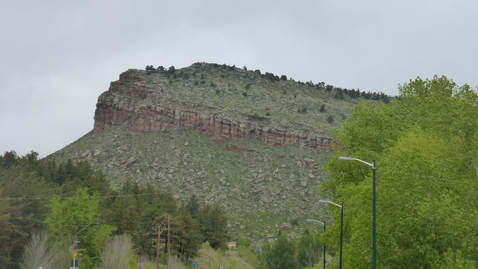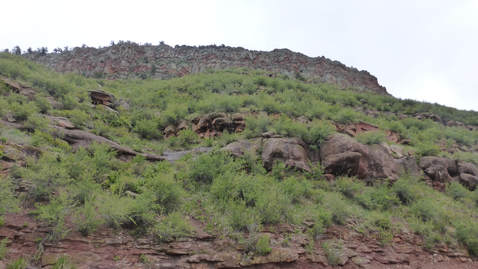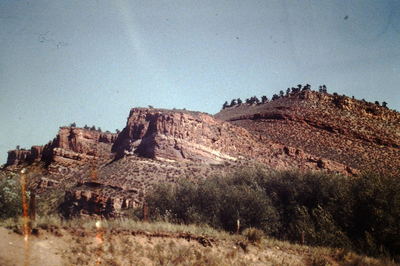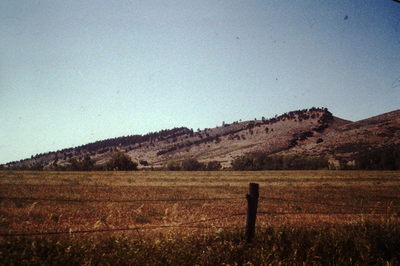Tilted beds of erosion-resistant sandstone rise from the desert plain, creating a long ridge with a decided asymmetry. On one flank of the ridge, slopes are smooth, gradual, and even, following the top of a hard rock layer. On the opposite side, the ground drops away in rough cliffs and steps, where the eroded-away edges of different rock layers are exposed. Clefts in the ridge-line mark places where small streams have cut back into, and partly breached, the sandstone ridge.
Dimensions The ridge is 100 feet (30 m) high, and a third of a mile (half kilometer) across. Smaller step-like cliffs on the rough side of the ridge may be 20-30 feet (5-10 m) high, with 60 feet (20 m) of near-flat surface above. (Hogbacks elsewhere vary quite a bit in width and height, but with the same asymmetry of slopes.)
Key Details

- The ridge top provides a commanding view of surrounding plains, and of the mountain slopes rising two miles beyond the hogback’s rough flank.
- Groups of low trees cover parts of the smoother flank’s gradual slope; many of these are arranged in lines, with roots exploiting long fractures in the sandstone.
- The flat ground below cliffs on the rough side of the ridge is a mixture of clay soils (from softer rock layers between the sandstone beds) and blocky boulders (fallen from collapsed portions of the sandstone beds).
- In the summer, clear daytime skies typically give way to early evening thundershowers, sometimes quite violent with hail, as banks of clouds roll off mountains.
- In the winter, cold winds may be especially fierce in the low stream-cut gaps of the hogback ridge.
Story Elements

- A group fleeing up the gentle slope pauses at the top, seeing a dangerous clamber downward to continue their flight. (This could be avoided by steering instead for the lower parts of the ridge crest, where small streams have cut further into the steep side.)
- The commanding view at the ridge top does not include the area directly beneath it on the rough face. This may give a false sense of security.
- A quiet consideration of this sharp ridge line, with oddly smooth slope surface on one side dangerously rough, broken precipices and rubble on the other, may give characters pause to consider severe contrasts in their own lives. The regional contrast seen from this vantage point, of mountains rising in one direction and broad plains extending in the other, might similarly support story themes.
- Once people approaching from the mountains get close enough to the base of the ridge, the lower cliffs will hide them from observers on the ridge crest. They will also be hidden from lateral view by the irregular inlet-and-promontory line of the lower cliffs.
- The hogback ridge crest and smoother slope are clear of rock debris, with scattered trees providing the only available cover on the broad slope surface.
- Something valuable or dangerous could be concealed in the bedrock surface fractures on either side of the ridge.
- The long fractures in the rock could be affected by some kind of catastrophic/unnatural force to open or shift in a dramatic way, highlighted by movement of the trees rooted there.
- Combat Dynamics:
- High ground on the ridge provides an observation point over the surrounding plain.
- The hogback crest is hard to attack from the rough flank, but easy from the opposite, gradually rising flank.
- On intermediate steps of the rough side of the hogback, loose boulders may be small enough to be pushed over cliffs as weapons, and more massive boulders there or at the base of the slope will be large enough to hide behind.
Reference Location
Foothills east of the Rocky Mountain Front Range, near Longmont, north-central Colorado.
© Rice-Snows 2017
Proudly powered by Weebly


